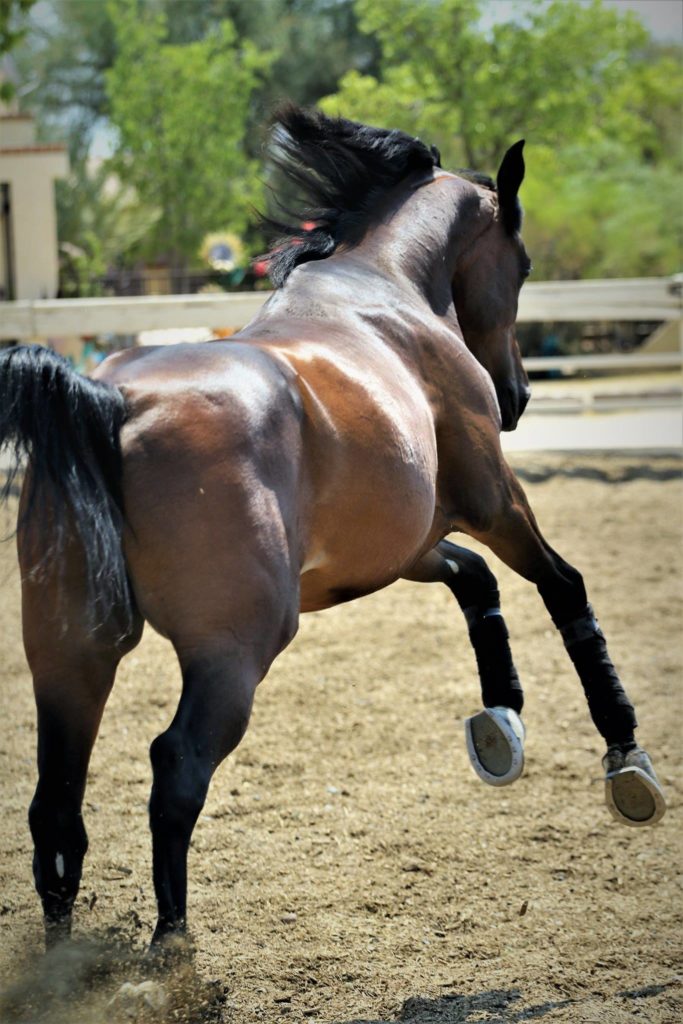How much do you know about your horse’s gait? Do you know why it’s important to know? Look no further! In the next two posts we’ll be exploring the horse’s gait and how it applies to you as an educated rider & owner.
First off, I want to make sure we know what the horse’s gait IS. Gait has to do with the order in which the horse moves each foot while traveling forward, also called “footfall sequence.” I’m sure you know horses have 4 natural gaits: walk, trot, canter, and gallop. (There are also “gaited horses” which have different gaits, but that’s a whole other discussion!) What differentiates the walk/trot/canter/gallop from one another isn’t just speed- it’s the actual ORDER in which the feet move. I’ll go into the specific order and get into details of each gait in part 2, but I want to take this moment to mention strides. Gaits are essentially the feet hitting the ground in a specific order and then repeating that pattern over and over. It’s considered one stride after each foot has hit the ground once and then the order starts over again and the horse begins another stride. It can sound a bit technical and confusing on paper if you’re not familiar with the terminology, but don’t worry, keep reading and by the end of our discussion it will all make more sense!
Knowing the footfall sequence of your horse is important for improving your riding ability and awareness (which I’ll discuss in a minute) but even more so, I want to stress it’s important so you know about your horse’s well-being. If you’ve heard someone say their horse is “lame” or “off,” they know that because the horse doesn’t feel or look right in their movement. If you know how your horse is supposed to move, then you’ll be able to tell if your horse is in pain when his gait is suddenly abnormal. You can’t tell when there’s a problem if you don’t know how it’s supposed to be normally.
Alright, back to why gaits are important when you’re on your horse. Having an understanding about the footfall sequence is the foundation to learning the basics of riding. When a beginner first gets on, feeling a walk is easy. It’s the “first” gait, it’s slow and smooth. Next, they learn that trotting or jogging is faster and bouncier. Then they’ll watch other riders canter/lope and usually call it “running.” This is fine at first, but if they hope to progress, they have to understand how the gaits work. Posting a trot, let alone on the correct diagonal doesn’t make sense If you don’t understand the beat of the trot. And learning the correct leads at the canter are impossible if you have no idea what a “lead” is…
I like to teach people how their lesson horses move their feet as soon as we start discussing going faster and how to post. It’s a significant piece of the puzzle If we want to be riders who truly understand how to work WITH our horses. Feeling gaits and the horse’s movement becomes even more important when we start training horses to do harder exercises or teaching a young horse. As a trainer, we need to be able to feel and know what’s going on underneath us so we can fix things when they start going astray.
To recap so far, we’ve learned what a gait is and should be comfortable with the terminology “footfall sequence.” We’ve discussed the importance of knowing what normal gaits look and feel like so we know if our horse may have an injury or problem of some kind. We also know understanding gaits is important for improving our riding ability so we can learn skills that are specific to certain gaits, such as posting the trot and canter leads (we’ll discuss what those are when we talk about trotting and cantering). As a more experienced rider, we appreciate how gaits intertwine with training our horses.
Now that we have a good foundation of why gaits are something every rider should know, join me next post and we’ll dive into the specifics of the 4 basic gaits of the horse and continue our discussion!
See you soon!
-Rebekah Bukowski

